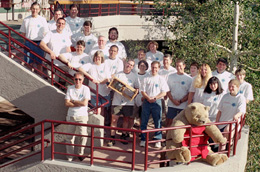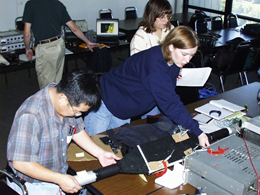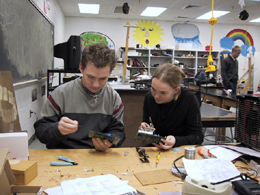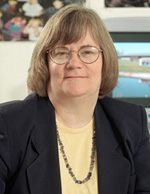 |
|
New Funding Raises QuarkNet Profile by Sena Desai
The 17 high-school teachers from 11 states who will visit Fermilab in June for a weeklong QuarkNet workshop will be among the happiest to learn that the physics outreach and teacher training program workshop is securely funded for the next five years, following joint reviews conducted by the Department of Energy and the National Science Foundation. NSF’s Education and Human Resources, Math and Physical Sciences Division, Elementary Particle Physics Division, and Office of Multidisciplinary Activities have together allocated QuarkNet up to $2,446,000 between 2003 and 2006;and DOE ’s Division of High Energy Physics has allocated $2,000,000.The funds will be managed by two QuarkNet founders,Marge Bardeen of Fermilab ’s Education Office and Randy Ruchti,a physicist at the University of Notre Dame,with Bardeen managing the DOE funds and Ruchti,the NSF funds. “Having multiple funding for programs is not without its challenges,”said Ruchti.“But a program like this,that can go on for ten years,is a real source of pride.” Some of this funding will be used to establish and maintain 10 new centers where high school teachers work with local particle physicists understanding the subject so they can teach it more effectively.
A new center has two lead teachers and two particle physicists from a local university or laboratory who act as mentors.The two teachers will spend eight weeks over the summer participating in experiments at CERN,Fermilab or any laboratory where their mentor works. The rest of the funds will be used to conduct one-or three-week workshops for teachers in QuarkNet centers that are more than a year old. QuarkNet now has six centers in the second year of the program.Each of these centers recruits more teachers,bringing their number up to about twelve for each center.The lead teachers and mentors will conduct three-week summer workshops for the new teachers. The rest of the centers have existed for three years or more and teachers will meet for an annual weeklong workshop discussing and sharing their physics teaching experiences. “We will organize meetings and conferences,and QuarkNet staff will continue to go out.Physicists will visit classrooms and students will come to see Fermilab,”said Bardeen. QuarkNet has a core staff of four principal investigators,two project evaluators,five high-school teachers,and a program secretary who coordinate the working of the centers. The program is now in its fifth year and 50 centers have been established. “We are at 50 which is a huge and marvelous thing,”said Ruchti.“We haven ’t got the 60 centers that we hoped,but we are close to our goal.”In all,there are 391 teachers from 352 high schools and 213 particle physicists currently participating in QuarkNet.
With renewed funding,QuarkNet staff can stop worrying about money and concentrate on establishing the 10 centers needed to achieve their original goals.And to strengthen the already existing centers. “We want to establish a sort of community — to bring teachers into the research community in their area,”said Bardeen. QuarkNet ’s success in getting teachers involved in their local particle physics research emerged clearly when teachers and physicists sat down together at the DOE-NSF QuarkNet review panel. The teachers all agreed that their involvement in QuarkNet had given them new respect at school from students,fellow teachers,principals and superintendents.They were looked upon not only as teachers,but experts in particle physics research.
“If a project can do this,it is doing a lot right,” said Marvin Goldberg,the program director for NSF ’s Elementary Particle Physics Division,who facilitated the development of QuarkNet.“Marge (Bardeen)has been an absolutely critical person,” he added.“Her ability to organize and Fermilab ’s ability to marshal resources have been an important part of QuarkNet ’s success.” Kathleen Turner,program manager of DOE ’s Division of High Energy Physics,who was on the QuarkNet review panel said,“One of the strongest points about QuarkNet is that a teacher in any town in the United States can work with a high-energy physicist to learn how research is done.And get some ideas on how to transfer the new knowledge to the students.” Goldberg says there are more DOE and NSF collaborations in which Fermilab will be involved. “I look forward to working with Fermilab and DOE in the future,”he says.
ON THE WEB: QuarkNet http://quarknet.fnal.gov
|



